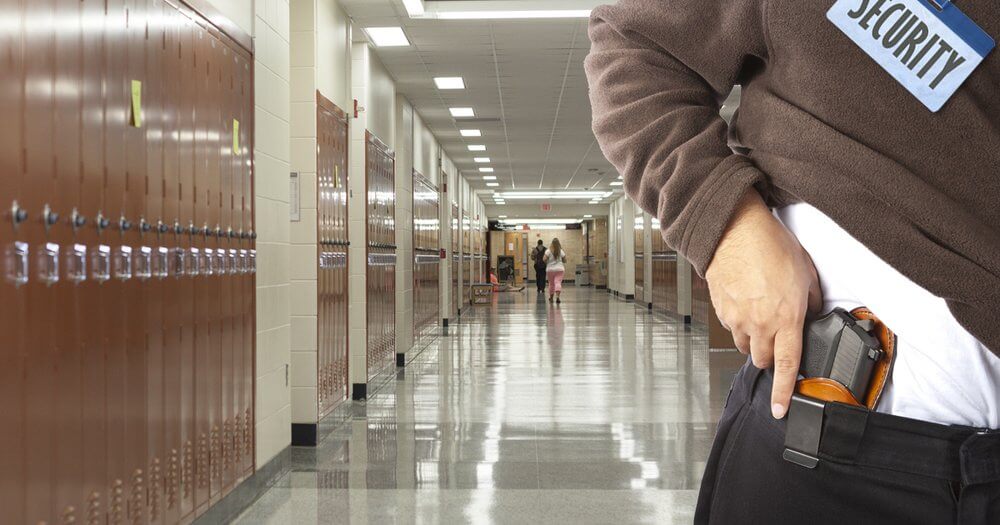Active Shooter Response for School and Church Security: Part 3
Active Shooter Response for School and Church Security - Part 3: Auxiliary Security Assets
The first article of our four-part article on school / church defense focused on the importance of integrating three elements into a cohesive plan of action:
The second article focused on seven suggestions for employing armed guards for school defense and how to integrate those guards into a larger plan/drill for responding to a deadly attack.
This article deals with the incorporation of “auxiliary security assets” into the overall security plan.
Note: While this article mainly refers to “school security,” the same principles apply to both schools and houses of worship (churches, synagogues, etc.)
- On-site armed guards
- Auxiliary security/support personnel
- Local law enforcement
The second article focused on seven suggestions for employing armed guards for school defense and how to integrate those guards into a larger plan/drill for responding to a deadly attack.
This article deals with the incorporation of “auxiliary security assets” into the overall security plan.
Note: While this article mainly refers to “school security,” the same principles apply to both schools and houses of worship (churches, synagogues, etc.)
Write your awesome label here.
Active Threat / Active Shooter Response Training
We offer unique Active Threat / Active Shooter Training for employees, as well as the most robust and comprehensive special training programs for security teams.

As discussed in the first article, the reason why it is important to consider training and employing auxiliary security assets is because local law enforcement and on-site school security organizations typically do not have enough manpower to achieve the breadth and depth of coverage needed to respond to unpredictable deadly attacks. The recurring pattern is that on-site security guards are typically outgunned and have trouble suppressing the threat alone. By the time support from local law enforcement arrives, even it if arrives quickly, the deadly attacker has often already managed to kill or injure many innocent people.
By harnessing the potential of untapped security assets within the school staff and local community, it is possible to increase the manpower and coverage of the security effort.
By harnessing the potential of untapped security assets within the school staff and local community, it is possible to increase the manpower and coverage of the security effort.
There have been numerous suggestions along these lines. However, there are several key points to consider when incorporating auxiliary assets into a security plan.
Actual Experience Matters
First, all auxiliary personnel should have as much prior training and combat or actual street experience as possible. The idea of training teachers and school personnel with no prior experience to handle a weapon in a high-stress situation is very dangerous, regardless of the length of the training program. Even new military and law enforcement personnel, who have gone through months of continuous training, can still make critical judgement errors or lose focus in a high stress situation because of lack of experience. Hardened combat veterans will confirm that it is typically only after numerous engagements that it becomes possible to remain calm and make sound decisions under fire. Therefore, all auxiliary personnel should already have extensive weapons training, and should ideally have real-world combat and/or law-enforcement experience if possible.
Size of the Force (and ability to control it) Matters
Second, the auxiliary force should also not be so large that it is difficult to organize and control in a crisis. On the extreme end of this spectrum, the solution of “everyone carrying a weapon” would certainly solve the manpower problem, but it would also increase the chances of accidents and friendly fire.
There are numerous cases of highly trained military personnel accidentally shooting each other if elements become separated or formations become disorganized, even when they are all wearing the same uniform and have American flag patches on their shoulders.
A large number of shooters in civilian clothes, spread across a campus and all looking for a deadly attacker leaves a high probability for tragic accidents. Therefore, it is critical to form auxiliary teams that are the right size and can operate in an organized, controlled manner.
Integration Matters
Third, in order for auxiliary security personnel to be effective and helpful they must be carefully integrated into a larger security plan that involves the official on-site armed security element and local law enforcement officers.
Local law enforcement should be responsible for the selection, vetting and training of auxiliary assets. Local law enforcement officers should also be overall responsible for the establishment/validation of the security plan and the employment of auxiliary assets in conjunction with on-site school security.
Plans might vary from school to school based on the unique requirements of each situation. However, there are some general guidelines that we suggest that might be helpful:
ALL of this must be practiced and rehearsed during school-wide deadly attacker or active shooter drills.
The final article in the 4-part series will discuss the leadership role of local law enforcement officers who will integrate the various elements described so far, oversee all planning and training, and ultimately arrive on-scene in time to control the situation and neutralize the threat if that has not happened already.
Actual Experience Matters
First, all auxiliary personnel should have as much prior training and combat or actual street experience as possible. The idea of training teachers and school personnel with no prior experience to handle a weapon in a high-stress situation is very dangerous, regardless of the length of the training program. Even new military and law enforcement personnel, who have gone through months of continuous training, can still make critical judgement errors or lose focus in a high stress situation because of lack of experience. Hardened combat veterans will confirm that it is typically only after numerous engagements that it becomes possible to remain calm and make sound decisions under fire. Therefore, all auxiliary personnel should already have extensive weapons training, and should ideally have real-world combat and/or law-enforcement experience if possible.
Size of the Force (and ability to control it) Matters
Second, the auxiliary force should also not be so large that it is difficult to organize and control in a crisis. On the extreme end of this spectrum, the solution of “everyone carrying a weapon” would certainly solve the manpower problem, but it would also increase the chances of accidents and friendly fire.
There are numerous cases of highly trained military personnel accidentally shooting each other if elements become separated or formations become disorganized, even when they are all wearing the same uniform and have American flag patches on their shoulders.
A large number of shooters in civilian clothes, spread across a campus and all looking for a deadly attacker leaves a high probability for tragic accidents. Therefore, it is critical to form auxiliary teams that are the right size and can operate in an organized, controlled manner.
Integration Matters
Third, in order for auxiliary security personnel to be effective and helpful they must be carefully integrated into a larger security plan that involves the official on-site armed security element and local law enforcement officers.
Local law enforcement should be responsible for the selection, vetting and training of auxiliary assets. Local law enforcement officers should also be overall responsible for the establishment/validation of the security plan and the employment of auxiliary assets in conjunction with on-site school security.
Plans might vary from school to school based on the unique requirements of each situation. However, there are some general guidelines that we suggest that might be helpful:
- In order to keep things organized and minimize the chances of accidents, auxiliary personnel should not “hunt” the deadly attacker. That is the job of the onsite security personnel who are ideally heavily armed, trained and equipped for that purpose. The auxiliary personnel should instead focus on helping innocent people escape and providing close-in protection for groups of fleeing evacuees. If groups of innocent people become trapped or isolated, auxiliary personnel can move to provide protection and guidance.
- All members of the auxiliary also don’t necessarily need to be armed. The auxiliary might include people with medical training or simply strong, athletic people who can help evacuate casualties. Therefore, while the main on-site security element should be “running to the sound of the guns,” all other auxiliary security elements should be running away from the danger, leading groups of evacuees to safety and helping stragglers and the wounded. If the auxiliary personnel are armed and they encounter a deadly attacker, they can engage the attacker in a defensive capacity to protect others.
- Auxiliary personnel should also carry radios or other communications equipment to relay information to the on-site security team that is hunting the attacker. Auxiliary personnel can use “grid reference guides” (GRGs) and other command-and-control methods to report the location of threats and direct on-site security to intercept.
ALL of this must be practiced and rehearsed during school-wide deadly attacker or active shooter drills.
The final article in the 4-part series will discuss the leadership role of local law enforcement officers who will integrate the various elements described so far, oversee all planning and training, and ultimately arrive on-scene in time to control the situation and neutralize the threat if that has not happened already.
©Copyright Special Tactics, LLC. All rights reserved.
Iron Survival, LLC
Featured links
Policy Pages
©Copyright 2026 Iron Survival, LLC
